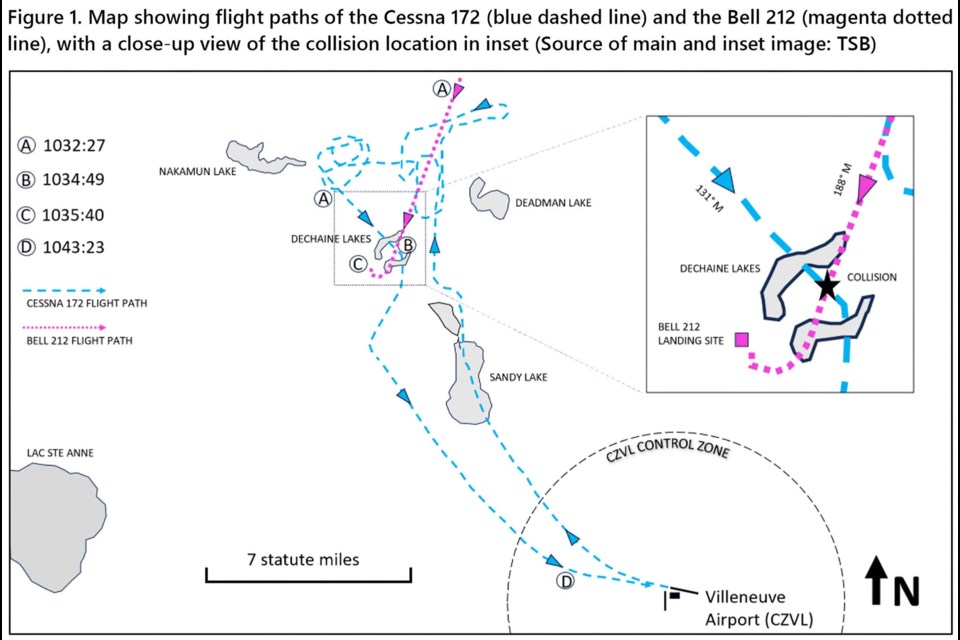Canadian planes and helicopters need new technology in order to prevent mid-air collisions like the one that happened last July near Villeneuve, says a federal agency.
The Transportation Safety Board of Canada released its report on the mid-air collision between a L R Helicopters Inc. Bell 212 helicopter and a Namao Flying Club Cessna 172M that happened near the Dechaine Lakes northwest of Sandy Lake on July 9, 2024.
The board launched an investigation of the collision to see if there were any safety lessons to be learned from it.
The circumstances
The collision happened at 10:34:49 a.m. in a region commonly used by the Namao Flying Club for training purposes, the board found. The helicopter, with one person on board, was flying southwest from the Fort McMurray Airport and entered the region at about 10:32 a.m. The Cessna, with an instructor and a pilot on board, had been flying around the region since 10:12 a.m. The helicopter pilot reported its position over the radio at 10 a.m., with the Cessna pilot doing the same at 10:12 a.m. Neither pilot received a reply to their reports.
At 10:33:34, the Cessna levelled off at 3,500 feet (about 1,067 m) above sea level to head southeast toward Villeneuve Airport at about 80 knots (148 km/h). This put it on a collision course with the helicopter, which was headed southwest at that same altitude at 114 knots (211 km/h). The pilots in the plane saw the helicopter passing from left to right in front of them and dived to dodge it, but could not avoid the collision.
The collision damaged the helicopter’s tail and put a large dent into the tip of the plane’s right wing, the board found. The helicopter pilot (who at the time did not know he had hit the plane) felt the impact and did an emergency landing in a field, suspecting mechanical trouble. The Cessna instructor told the chopper pilot about the collision, then continued on to Villeneuve Airport once the downed pilot reported that he was safe. No one was injured in the collision, but both vehicles required extensive repair.
The Namao Flying Club (which did not respond to requests for an interview for this story) has moved its training flights to controlled airspaces since the collision so they could have the protection of air traffic controllers, the board noted.
Analysis
St. Albert pilot Bill Carter (who has flown various planes for about 58 years) said he was flying in the vicinity of this crash when it happened and heard the helicopter pilot’s mayday call over the radio. He also later saw the damaged Cessna, whose wing was “pretty much destroyed.”
“It was amazing they were able to land the airplane,” he said.
Asked to review the board’s report on the crash, Carter explained that aviation best practices say pilots should report their position regularly over the radio so other pilots know how to avoid them — which both pilots did in this case. What they didn’t do was use those reports to stay at least 1,000 feet apart vertically. In this case, the helicopter probably should have been flying at 4,500 feet, not 3,500 feet.
The board noted that pilots flying by sight are supposed to spot and avoid oncoming traffic — an approach their investigations into other mid-air collisions has shown to be ineffective.
There are plenty of reasons why a pilot might not see an oncoming plane, Carter said.
“There’s a lot going on in an airplane,” he said, and a pilot might be busy checking a map or talking to someone, or have their view blocked by a wing or strut.
The board said Canada would not significantly reduce its risk of mid-air collisions unless it equipped all aircraft with traffic awareness systems — gadgets that transmit your position and alert you if you’re on a collision course with another plane. The helicopter in this crash had such a system, but the plane did not (and wasn’t legally required to).
The board advised pilots to follow best practices for setting their altitude during flight (as described by Carter above), regularly report their position on the radio, and ensure they know of all types of flight operations that take place along their route. They should also consider adding traffic awareness systems to their aircraft.
Carter urged all pilots to read this report to learn how to avoid future collisions.
The report is available at bit.ly/3XHAwem.




